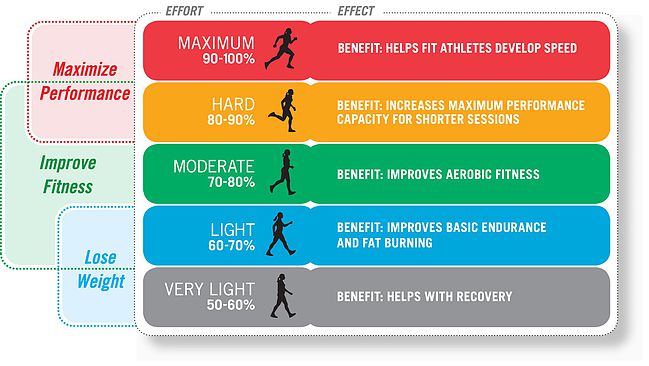How to use intervals to accelerate Fat Loss!
Gone are the days of running aimlessly on the treadmill and cycling for hours to lose body-fat. Or at least, they should be gone.
We are at a point in time where we are blessed AND cursed with a plethora of information. Some is useful, and some is useless.
As the wise man Bruce Lee once said, “Absorb what is useful, discard what is useless and add what is specifically your own”
This is the attitude which you should have in today's day and age with all of the information and resources available to you.
What does this have to do with fitness and losing body-fat!?
Everything!
It means that there is a more effective and time-efficient way to lose those extra kg's!
Let me just outline a few major points so you understand WHY the old method (long, steady-state cardio) was, and still, is used.
The picture illustrates the different 'Heart rate ranges'. As you can see, the "Fat burning zone" is quite low in terms of the intensity (In %).
What happens is, that when you perform exercise at a low intensity, like 50-70% is that fat is used as the primary fuel source, as the body's mechanism can sufficiently use and convert it into energy.
This is NOT the case when you exercise at a higher rate or intensity level.
So, that means the fat burning zone is better for fat loss then!? Well, sort of.
Working in the fat burning range predominantly uses fat as energy. Yes. However, for it to truly be effective you will need to be in that range for a long period of time. Like 45-90+ mins.
I don't know about you, but I just don't have that time to exercise each and every day!
That is where intervals come into play.
Intervals, or interspersed repeat efforts, performed at a higher intensity are a fantastic alternative instead of the longer style work.
The body uses a different energy source (carbohydrates) as fuel, but the effects AFTER training are where the gold lies!
There is a phenomenon know as EPOC, which occurs after you finish exercising/training. It stands for Energy Post-exercise Oxygen Consumption.
What happens is that when you exercise at such a high intensity, your body can't uptake enough oxygen to maintain the workload and function, creating an oxygen debt.
The bigger the debt, the more calories you will burn AFTER TRAINING. This is to restore the oxygen levels (to normal) and repay that debt.
Depending on your intensity, you get a good overlap of training outcomes. You can improve heart function, fitness, increase lean muscle mass as well as make training more effective due to the higher intensity.
Below I will outline some ways that you can implement intervals into your training. The main method/s that I use for intervals are running, and the Concept 2 rower.
TRAINING CYCLE 1
-5X300M WITH DIMINISHING REST PERIODS
*1,500m TOTAL*
Wk 1=2 mins rest between efforts
Wk 2=90 sec rest
Wk 3=75 sec rest
Wk 4=60 sec rest
This is a great entry level into intervals. The distance is short enough that you don't get overwheled by the duration and you can also back up the efforts for the required 5 sets.
Training Cycle 2
-4x400m with diminishing rest periods
*1,600m TOTAL*
Wk 1=2 mins rest between efforts
Wk 2=90 sec rest
Wk 3=75 sec rest
Wk 4=60 sec rest
The rest period scheme stays the same, but what changes is the sets and reps. We perform a longer distance, BUT, we reduce the number of sets. This makes it achievable, whilst sneaking in an additional 100m overall :)
TRAINING CYCLE 3
-6x250M WITH DIMINISHING REST PERIODS
*1,500m TOTAL*
Wk 1=2 mins rest between efforts
Wk 2=90 sec rest
Wk 3=75 sec rest
Wk 4=60 sec rest
The last block of the intervals is the hardest, by far!!
The duration reduces, significantly (150m) per set, which means you can increase the intensity. The overall volume however reduces back to the initial 1,500m to accomadate the extra power output.
Here is one of my client's reactions after doing Wk 2 of Cycle 3. (Language warning)
Feel free to print this off and use it in your own training sessions.
My recommendation is to start with cycle 1, completing 1 session per week. Then move to cycle 2 and do the same thing.
If you feel you REALLY struggle with a cycle, simply repeat it after the cycle is finished, but this time try to beat your previous times!
I have personally used this format and can say without a doubt that it will increase your fitness! If your nutrition is good and you also manage your recovery.
The key points that I want you to take away from this article are;
Intervals need to be challenging
- They should be hard. If they're not, you won't get the benefit.
- Keep the work period short
- Focus on quality, NOT quantity. 4 good intervals will be better than 10 crap ones!
There are many ways to include intervals in your training, and this is just 1 way.
For more information on how to use intervals or get your own specialised training programme made up, feel free to contact me via email HERE.
Until next time,
Happy training!
Jesse
DO YOU LIKE MY ARTICLES AND FITNESS TIPS?
I send out my weekly newsletter, 'Fitness Advice That Works In the Real World', every Tuesday to help people like you, lose fat, build strength and create results that last.
Check it out here.

